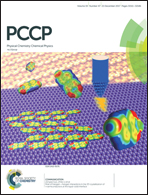Insight into the effect mechanism of urea-induced protein denaturation by dielectric spectroscopy
Abstract
Dielectric relaxation spectroscopy was applied to study how urea affects the phase transition of a thermosensitive polymer, poly(N-isopropylacrylamide) (PNIPAM), which has been widely used as a protein model. It was found that there is a pronounced relaxation near 10 GHz for the ternary system of PNIPAM in urea aqueous solution. The temperature dependence of dielectric parameters indicates that urea can reduce the lower critical solution temperature (LCST) of PNIPAM, i.e., stabilize the globule state of PNIPAM and collapse the PNIPAM chains. Based on our results, the interaction mechanism of urea on the conformational transition of PNIPAM was presented: urea replaces water molecules directly bonding with PNIPAM and acts as the bridging agent for the adjacent side chains of PNIPAM. Accordingly, the mechanism with which urea denatures protein was deduced. In addition, it is worth mentioning that, from the temperature dependence of the dielectric parameters obtained in the presence of urea, an interesting phenomenon was found in which the effect of urea on PNIPAM seems to take 2 M as a unit. This result may be the reason why urea and TMAO exit marine fishes at a specific ratio of 2 : 1.



 Please wait while we load your content...
Please wait while we load your content...